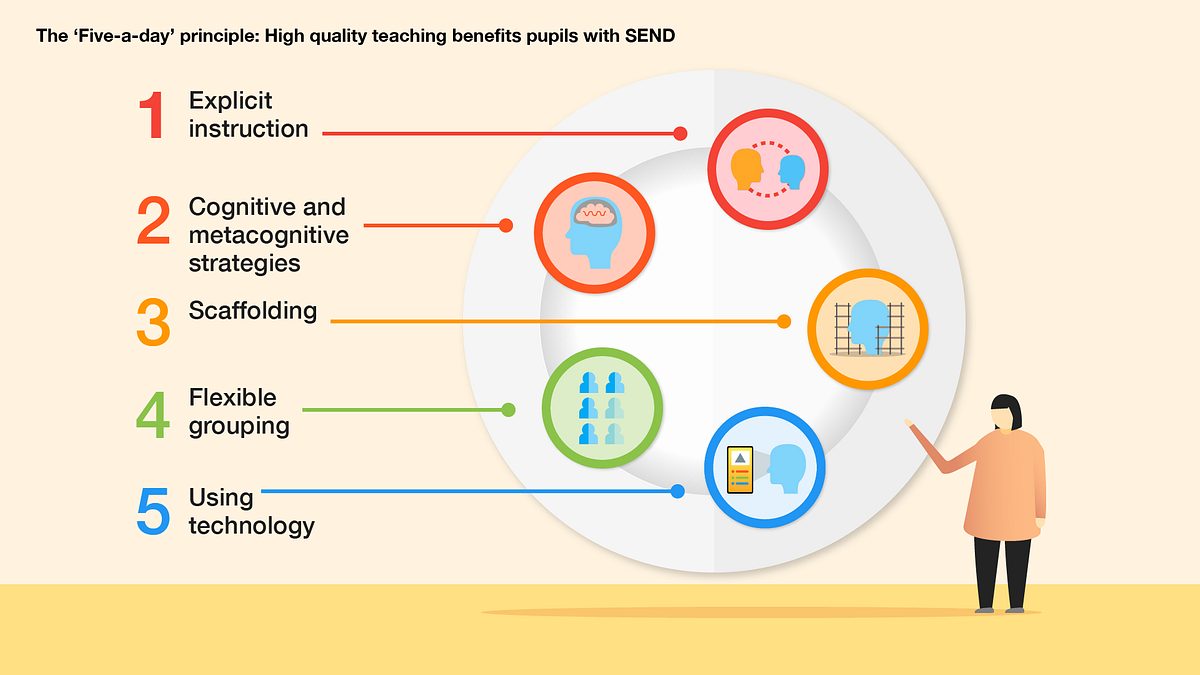SENDCOs have a specialised knowledge of the steps practitioners can take to support pupils with additional needs. They know the areas where their school excels in this regard, as well as what the evidence suggests in terms of making purposeful improvements. But how can SENDCOs take their own knowledge and ensure it meaningfully impacts teachers’ practice in classrooms?
More so than ever, teachers are juggling numerous competing priorities – some old and some brought on by the pandemic. As a result, exploring evidence relating to supporting students with SEND might understandably fall down their lengthy to-do lists.
Fortunately, the best available research indicates that gains can be made for pupils with SEND without an overhaul of existing practice. In fact, it suggests that familiar teaching approaches – illustrated in the EEF’s new ‘5‑a-day’ resource – can benefit these pupils, and their peers:
- Explicit instruction
- Cognitive and metacognitive strategies
- Scaffolding
- Flexible grouping
- Technology

These strategies may already be familiar to mainstream teachers, however, emphasising the potential impact that these approaches can have for pupils with SEND may prove a valuable step in changing practice.
As all SENDCOs know, developing teacher practice around SEND is about more than just raising awareness of a teaching approach. Teachers may need support to develop or change what they do in the classroom.
Behaviour change and the COM‑B model
It is useful for SENDCOs to carefully consider what changes they would like to support teachers and TAs to make. The ‘COM‑B’ model can be used as a framework to consider how a SENDCO can support behaviour change in their school:

This model (adapted from Michie et al, 2011) can help SENDCOs to consider what it is that prevents teachers from adopting new behaviours – i.e. the teaching practices – that support students with SEND to thrive. By reflecting on capability, motivation and opportunity, SENDCOs can ensure that evidence-informed changes to practice can be successfully embedded in classrooms.
Capability
Do staff have a strong understanding of what good, evidence-informed teaching looks like for students with SEND, so that they can then implement it?
This reflection tool can support teachers to consider their own practice in terms of the ‘5‑a-day’ strategies. It can help them to establish the concrete habits that sit behind terms like ‘explicit instruction’ and ‘cognitive and metacognitive strategies’.
It may be that a SENDCO needs to work with colleagues who drive teacher development in their school in order for this to support behaviour change at the whole-school level. The EEF’s Effective Professional Development guidance report can support the design and implementation of successful CPD programmes to meet this aim.
Motivation
Are staff motivated to develop their teaching practice for students with SEND?
If not, SENDCOs may need to consider whether to speak to staff about:
- The strength and credibility of the evidence around the ‘5‑a-day’. The EEF’s Special Educational Needs in Mainstream Schools guidance report and the Evidence Review that informed it can help with this.
- Ways in which teachers can change their practice and implement the 5‑a-day, that won’t involve re-planning all their lessons.
- The right of all parents to select a mainstream education for their children.
Opportunity
Are there wider factors that might prohibit teachers from putting in place some of these strategies? A SENDCO might need to consider, for example:
- Do these approaches complement or contradict wider messages being given to staff around effective teaching?
- Have Teaching Assistants received training about the ‘5‑a-day’ and the implications for how they carry out their role in class?
- Does their school have the resource (student laptops, visualisers) to make using technology a realistic approach for teachers?
Developing the ‘5‑a-day’ approach won’t replace the need for staff to know their learners as individuals. It won’t lessen the need for the pupil in Year 8 with a visual impairment to have an increased font size or for the autistic child in Year 2 to have a visual timetable. It will, however, give teachers a number of evidence-informed approaches that support all learners to access classroom learning.
By considering what might be preventing teachers from implementing new approaches in their classrooms –through the lens of capability, motivation or opportunity – SENDCOs can ensure that lessons from the evidence become embedded in teaching practice for the benefit of pupils with additional needs.

Guidance Reports
Special Educational Needs in Mainstream Schools

Blog
EEF blog: ‘Five-a-day’ to improve SEND outcomes


Guidance Reports